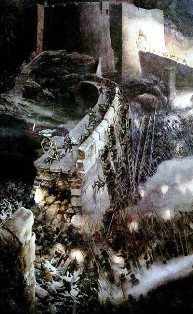
Battle of the Hornburg (by Alan Lee)
|
It may be a long way back to recapture audiences lost to classical music through the disappearance of music education from the schools, changing lifestyles and perceptions of elitism, but the way back may be through places like Middle-earth.
The average age at Saturday night’s performance of Howard Shore’s “Lord of the Rings Symphony” by the Cincinnati Symphony Orchestra at Music Hall
appeared much younger than the normal mid-50s demographic. CSO staffers scrambled to handle the walk-up traffic just minutes before the concert, and it
seemed that only the unsellable seats in the 3,516-seat hall (several hundred are limited and obstructed views) remained empty.
German conductor Markus Huber, a very impressive figure on the podium, led the CSO, May Festival Chorus, Cincinnati Children’s Choir and vocal soloists (over 200 performers in all) in an engrossing multi-media presentation that included images by Tolkien artists John Howe and Allan Lee projected onto a screen above the orchestra.
The symphony – really a six-movement, programmatic suite condensed from Shore’s 12 hours of music for the Peter Jackson films – lends itself perfectly to
visual enhancement. The images track events in the J.R.R. Tolkien’s epic trilogy about the struggle to keep an all powerful ring out of the hands of evil forces
(same theme as Wagner’s “Ring of the Nibelungs,” both based on Nordic mythology). The drawings are soft, atmospheric and unobtrusive, keeping listeners
in tune with the complex story without diminishing the music. Shore’s deployment of the choruses and his highly percussive writing bring inevitable comparisons to Orff’s “Carmina Burana.” Prokofiev’s cantata “Alexander Nevsky” also comes to mind, as does Holst’s “The Planets” (especially “Mars”) and the over-arching example of Wagner in its dramatic scope and use of leitmotifs (recurring themes).
There is a world of color in the music. Lighting up the Shire (home of the Hobbits) were Irish flute, skillfully rendered by Joan Voorhees on piccolo, “fiddle” by concertmaster Timothy Lees and Scott Lang on cimbalom (hammered dulcimer). The CSO percussionists were an army unto themselves on drums large and small. The bass drum was liberally applied in lieu of Japanese taiko drums. That rattling sound was “distressed piano,” i.e. an upright with implanted nuts and bolts played by strumming the strings. And if you thought you heard bagpipes once or twice, it was the oboes forgetting all they were taught about creating a beautiful sound.
Choral parts and much of the solo writing is in “Tolkienese” (languages derived by Tolkien from Finnish, Welsh, Old English, etc.). The choruses delivered it all with eloquence, skill and episodes of pulse-quickening savagery.
Star of the show was soprano Kaitlyn Lusk, a teenager from Pennsylvania with a beatific voice and stage presence to match. Her stylish performance of the wrenching “Gollum’s Song” and Shore’s 2004 Oscar-winner “Into the West” from “The Return of the King” went straight to the heart and brought the audience to its feet.
Mezzo-soprano Andria Helm, baritone Adam Fry and soprano Liza Forrester, graduate students at the University of Cincinnati College-Conservatory of
Music, filled their assignments beautifully, Helm projecting a pure vibrato-less tone in “The Bridge of Khazad-dum,” where she mourns (in Elvish) the wizard Gandalf after his encounter with the demon Balrog.
Shore’s “Lord of the Rings Symphony” has been performed over 100 times since its premiere in 2003 in New Zealand and seems to have a cult following
already. According to the CSO, people from 15 states (excluding Ohio, Kentucky and Indiana) as well as visitors from Wales and Portugal were here for the
event.
(first published in The Cincinnati Post Oct. 1, 2007)